1
1911-19191911
With J.J. Kelso's influence and help from G Frank Beer (President of The Toronto Housing Company) George P. Bryce and Arthur H. Burnett open Central Neighbourhood House. They choose 84 Gerrard St West, central to the people they want to reach (in the heart of "The Ward"). American, Elizabeth Neufeld is hired to run the house as Head Girl. Within six weeks there were thirty-four recreational and educational activities operating; from play hours for little children, self governing clubs for children and young people - eight to eighteen, as well as English classes for adults and a private library stocked with 800 books.
1912
The first spring festival was mounted. It was the highlight of a series that began the previous October and culminated in May featuring performers from numerous Toronto Conservatories. The festival included the settlement's first publicly performed play put on by a girls' dramatic club. In charge of that production and others was Dora Mavor (Moore) daughter of U of T professor James Mavor. She would later become an Icon of Canadian Theatre. The Annual theatre awards, "The Doras" are named after her. During the festival 350 Geraniums were distributed by the Toronto Parks department to Ward families who were to return the plants for judging in the fall.
In the Summer of 1912 with regular programming down for the season at the house, picnics and summer camps to High Park and The Toronto Islands were organized for the first time. With support from the Toronto Star's Fresh Air Fund 350 children and 50 mothers took part.
Late in the summer of 1912 "The War of the Playgrounds" erupted after it was discovered that CNH was in line to get funding ($15,000) to move into the Old Elizabeth Street Schoolhouse after it was moved to the centre of the playground and renovated (as you can imagine it was a wooden structure and not too large). Other groups in the area demanded equal, or greater support if CNH was granted its proposal - it was suggested that the Judizers at CNH had wangled City Hall for special treatment - it even made the papers). After a special sub-committee reporting on the situation stated there were ten other groups doing similar work in the area, no amount of protest in the media or by Parks Commissioner Charles Chambers (who administered the three Playgrounds run by the Parks Dept.) could sway an unsympathetic City Council from turning down CNH's request. It was a bitter blow. Somehow CNH pulled up its socks and acquired 82 Gerrard West, put a door into the adjoining house and carried on in more but still cramped space.
The Elizabeth Street Playground and the St Andrews Playground were the first to be administered by a City Department in North America (1908). By 1912, the Commissioner of Parks administered three City Playgrounds. Charles Chambers was more progressive in his approach to parks (considering the needs of children). His father, John Chambers, as Commissioner of Parks had a more Horticultural approach. He was known to use the police to remove unwanted children from Parks and Flowerbeds and to discourage disorganized play.
Still, in 1912 on Sundays, playground equipment was removed and the playground was locked up. In the Ward this led to the Sunday Children's Parades. Organized by Central Neighbourhood House these Parades were made up of the children of the Ward, some volunteers, some mothers, and CNH staff. With musical instruments and noise makers of various kinds (garbage bins, and lids, pots, tin cans), they marched through the streets of the Ward loudly advocating that the playground(s) be opened on Sundays so they would not have to play in the street.
The children's parades culminated in the children's March on City Hall. At first they were turned away by aggressive policemen, but the presence of the press soon led Mayor Hocken to intervene. They were led triumphantly to the city controller's office where they met together. Though this event made headlines in the Toronto papers, it was almost another ten years before playgrounds were to remain open on Sundays.
1913
The milk depot and the well-baby clinic established in the summer of 1913 in cooperation with the Hospital for Sick Children and the welfare nurses of the City Health department were the most important of new neighbourhood services. They opened up contact with local families. This was the beginning of Public Health in Toronto.
The summer of 1913 also saw the first camp experiment. Mary Millman, then a young student volunteer took a group of girls 15 to 19 to the farm of Mrs. L.A. Hamilton at Lorne Park. They all survived and reportedly gained weight. (She would become a lecturer of public health at U of T)
There had been many successful day outings, but Elizabeth Neufeld felt strongly that the ideal was to have a country home where families could have a few weeks of rest. The summer of 1914 saw Neufeld's dream realized.
1914
The newly opened Summer Camp closed early due to the impending War.
1915
The War years meant reduced funding, limited programs, and concentrating on the war effort. Families suffering from the effects of the war were the focus. Still, the House (Vera Parsons) opened a music school.
1918
In her article in "The Ward Graphic: Happenings in the Heart of Toronto," Mary Joplin Clarke, Head Worker at CNH, called for a "New kind of Sunday in which the public school could become the neighbourhood clubhouse." An appropriate suggestion considering the Board of Education had not allowed for the renewal of permits for recreational programming since 1915.
1919
With the war over the need for settlement services was greater than ever. Despite having moved into the house next door at 82 Gerrard Street, CNH was bursting at the seams. Programs used spaces outside the house(s). The larger townhouses at 25 and 27 Elm Street meant more space, and a gymnasium was rented in a factory around the corner. For a time there was even room for a small library branch at the house. It provided books and materials and enticed people to seek out the other Toronto Library branches.
2
First Central Neighbourhood House at 82-84 Gerrard Street1911
Central Neighbourhood House, Toronto
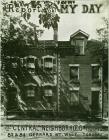 Credits:
Credits:Central Neighbourhood House Records
3
1920s & 1930s1920
CNH becomes a founding member of the Federation for Community Service (the United Way)
1923
Central Neighbourhood House became a beehive of activity. Total attendance at the settlement for the year was 27,000.
1924
The Department of Social Service at U of T approached the settlement to find placements for student social workers.
1925
As the Twenties progress "The Ward" becomes less residential and more industrial. Blocks of houses are razed and replaced with factories. The Toronto General and Sick Children's Hospitals expanded and took up the Elizabeth Street playground between them. Gerrard Street is extended to University Avenue. The face of the neighbourhood changed. The programs of CNH responded.
1926
Eleven University of Toronto students placed at CNH through the academic year.
1927
It becomes ever more apparent that immigrants are moving to the west and east of the Ward. There is a need for a new settlement east of Yonge street.
1928
CNH moves to an empty school at 12 Pembroke Street between Dundas and Shuter Streets, east of Jarvis (and George streets).
1929
The Board of education requires the school on Pembroke, CNH has to move. Dr. Rekai who owns 349 Sherbourne and has his practice there, rents the majority of the place to CNH, keeping a space in the back (off what will become Central Hospital Lane) for his medical practice. Eventually, CNH buys the House and remains at this site for the next 40 years. The House was originally built by Sir Henry Pellatt (before he built Casa Loma). When the doctor retires, CNH takes over the whole house. By 1971 the house is demolished and becomes part of Central Hospital. Today it is the site of The Rekai Center, a seniors' chronic care facility.
1930
education and women's clubs become a major focus to improve the quality of life for children.
1932
Under the direction of a faculty member from the University of Toronto's Department of Psychology, a parent education group met every second week to discuss the most up to date research and views on the best methods of raising children.
1933
By January 30% of Toronto workers were unemployed. CNH continued to run well baby clinics supervised by the City's Department of Public Health.
1934
Members of various Women's clubs exhibited and sold quilts at the CNE. CNH reported that by year end there were no more cases of malnutrition among the children visiting the agency. Spring festival held at St Bart's Church in Regent Park is a success, and draws Women's groups from the old neighbourhood in The Ward.
1935
By early February 25% of Torontonians were on relief. Despite the best efforts, CNH was not able to come to grips with one of the Depression's most intractable problems - the lack of adequate housing. Families were cramped into rooms, or worse.
1939
By the end of the decade, CNH's camp on Lake Simcoe "The Gables" was a regular place for CNH activities. 400 children went every summer, and many, many mothers attended as well. But the Second World War had started.
4
Central Neighbourhood House, 25-27 Elm Street1920s
Central Neighbourhood House, Toronto
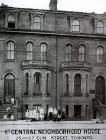 Credits:
Credits:Central Neighbourhood House Records
5
1940s - 1960s: War, Post-war, and Social Change1940
The sudden death of long time ED Helen Austin ushers in a new era of uncertainty, but the Summer camp remained open for two more years. The focus for the rest of the war was on supporting the war effort and assisting with child care for working mothers.
1942
With War Shortages The Gables is closed. CNH improvises with Summer Day Camp. A success with working mothers, this program continues to the present.
1945
Honorah Lucas, hired in 1942, faced the challenges World War 2 brought to CNH. "The combination of absentee fathers and working mothers had a drastic and somewhat bitter effect upon the families concerned, adding considerably to feelings of unrest and instability."
1946
Without Vera Parsons to run it, the Music school closes.
1947
Preschool and well baby clinics close. CNH opens the Nursery School and after school programs.
1948
Helen Sutcliffe, former army nurse is hired as head worker. Regent Park redevelopment begins. CNH participates in moving families and individuals displaced by demolition.
1949
The Cabbagetown Gang with over 100 members makes CNH their headquarters. The board instructed Sutcliffe to end this relationship. Instead she worked with them directly. Her success was great enough that she was approved to continue after her one year contract ended. She stayed until1971. Many former gang members stayed in touch for years afterwards.
1950
A greater focus is put on older children and youth, in an age of rising dropout rates and juvenile delinquency. New recreational activities are created to attract teens to the House. The three year school completion project began.
1953
Helen Sutcliffe sets out three principles of policy. To work with people to live together, achieve individual growth and create good relations; To recognize the needs of the community as a major factor in securing better living conditions and creating a sense of responsibility for local conditions; and To relate the concerns of local neighbourhoods to the whole community.
1956
The attendance at the various clubs, classes, interest groups and the nursery school numbers 72,000.
1959
Forty two percent of teen boys registered for programs at CNH had criminal records or were on probation.
1960
Over the previous decade the population of Toronto had grown from just under a million to almost 2 million by decade's end. CNH continued to be unable to meet the needs for adequate or enough housing.
1963
Toronto City Planning Board report on the Don District outlined the problems of the neighbourhood. The area represents 6% of the city's population, but it had 11% of the CAS cases, 12% of the city's juvenile offenders, 19% of the welfare recipients, 34% of drunken offenders, and 65% of the homeless men. Most of the housing was 70 years old and 25% was crumbling rooming houses, far more than exist today.
1964
Ground breaking study (first of its kind in Canada) and support for aboriginal issues. The Urban Canadian Indian Family Project began. An in-depth report on the School completion project is provided to the City of Toronto.
1965
"The Culture Club" formed at CNH to help high school students overcome the social, economic and environmental inadequacies of their neighbourhood. A report on the Urban Canadian Indian Project is presented to the City of Toronto. With the support of the T. Eaton Foundation, Department of Citizenship and Immigration, Government of Canada, and the Department of Welfare - Government of Ontario, this becomes an important reference for urban aboriginal policy in numerous municipalities..
1966
CNH participated in the St Jamestown redevelopment, helping re-house those affected by demolition. A final report on the Unreached Youth Project (girls) (1964-66) is presented to the City of Toronto. In it, case studies and recommendations of Female juvenile delinquents are presented. Considering the time it is an exceptional reference to Social work with teenage girls.
1967
The St Jamestown Project brought nine agencies together to assist families in the area who faced many problems, including relocation. A report on the Summer Outreach Project is submitted to the City of Toronto. In it CNH describe the experience of trying to connect children and youth to the programs and activities of the House.
1968
By this time, every fifth person coming to the house for programs was from the East Coast of Canada. Programs and committees, made up of earlier arrivals worked to welcome and familiarize newcomers.
1969
The National Film Board assisted a group of youth from the House, script and produce a film of their lives.
6
Central Neighbourhood House at 349 Sherbourne Street1929
Central Neighbourhood House, Toronto
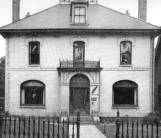 Credits:
Credits:Central Neighbourhood House Records
7
1970 - 2010: A Home of their Own at 349 Ontario Street1970
The fundraising committee with the help of the community, and many donors, raise $700,000 to build the new House at 349 Ontario Street, which opened on December 5. One of the most effective fundraising tools was the Children's Parades. Escorted through the streets of Toronto by CNH Staff, children made noise soliciting donations to build a new house for the settlement in the neighbourhood
1971
Nursery School closed. Central Neighbourhood House Daycare opens in the new House. Home Support Program began with one worker. Donwest Neighbours Group began. Food club selling groceries from the House.
1972
Phenomenon known as "Whitepainting" began. With the Zoo and some of the industry gone some of the eastern downtown becomes living space for young professionals seeking an alternative to the suburbs. Low cost rentals and rooming houses begin to decline. Donwest Neighbours Group formed (homeowners, tenants and businessmen) intent on improving housing conditions in the area.
1973
Community worker involvement in tenant organizing in Moss Park and later in the Dundas and Sherbourne Housing Projects, and with the Seaton Street Residents Association.
1974
Staff support given to the Don District Community Health Centre when it opened in September. For some time one of the three locations for the clinic had been the House.
1975
Staff worked on the Skid Row Committee and the Single Displaced Person Project when it became apparent that the over-crowded and burgeoning shelter was inadequate to handle the numbers of displaced and homeless person there were in the area.
1977
After a 7 year relationship instrumental in SOCCA (South of Carlton Community Action) which involved a major local planning study, and various projects under the Neighbourhood Improvement Plan, CNH left the group after it became dominated by the interests of newer and more affluent residents (Whitepainters), whose goals for the area did not always match those of the House.
1978
Toronto Board of Education and Metro Social Services ran a Nutrition Education course at the House
1980
Black Heritage program started. Opportunity for the Advancement of Women program began. Adult Drop in opened.
1985
Since moving to Ontario Street the annual budget has doubled: from $400,000 to $800,000.
1987
After more than fifteen years on Ontario Street, the house is beginning to wear. CNH begins to think about expanding.
1993
After a long capital campaign most of the programs move out of 349 Ontario St to accommodate renovations.
1994
With the renovations complete, programs begin to move back to the house. When it comes time, The Adult drop in is refused at the house. The local neighbours get an injunction to stop the move. The confrontation that results, sees the firing of the Drop-in manager. To end the dispute, the Adult Drop is moved to 60 Richmond and joined with Dixon Hall's Shelter (moved out of Corktown to accommodate neighbours there). This was a rocky relationship that almost culminated in amalgamation. In the end the two programs were split and the Drop in moved to Metropolitan United Church where it became part of CNH's shelter program there. The idea of amalgamation with Dixon Hall is dropped.
Home Support became too big for the House, and moved to 517 Parliament Street; now half the organization works in this program (50 staff).
1996
Barry Thomas hired as Executive Director. He is the first male Head Worker,
1997
In conjunction with the city's Shelter, Housing and Support Department, CNH begins a pilot program of outreach to people living outside (Street Survivors).
Workers at CNH vote to join a Union. CUPE is chosen to represent them.
1998
CNH opens a 40 bed shelter in the Gymnasium of Metropolitan Unted Church. The Street Survivors Program becomes a continuous program of outreach and housing for chronic homeless people.
1999
CNH negotiates its first collective agreement (2 years) with CUPE.
2001
The Drop in moves to the site of the CNH shelter in the gymnasium of Metropolitan United Church.
2002
CNH reaches a high spot. The annual budget reaches 8.5 million dollars.
After negotiation breaks down in talks for a 2nd collective agreement with CUPE, CNH workers go on strike for 6 weeks. Some programs shut down, some move to other locations. Clients of Home Support move to other agencies.
Settling the strike puts a further financial strain on CNH.
2003
The Shelter and the Drop in are forced to move from the Metropolitan United Church to make way for Condos (by 2011 the Condos are not built). The Programs move to 321 Jarvis St, the site of an old Hotel (1840). Facilities are inadequate.
2004
CNH opens a second Daycare at Winchester Public school. Like the one at the Main House, The Winchester Daycare is run under strict guidelines for conditions and staff qualifications.
2005
Difficulties at the shelter and pressure from the city and community force the closing of CNH's shelter. Some thirty-five workers are laid off. With help from the City, 50 residents are relocated (mostly housed in rooms and apartments).
2006
The threat of competition in the Homecare sector leads to negotiation with Woodgreen Community Services and Seniorlink. A new organization is formed - Toronto Home Support - made up of all three organizations. CNH shrinks by some 120 workers. After twenty years CNH is now small enough to fit in one building again, 349 Ontario Street.
2007
CNH reaches a low point. The annual budget is reduced to 4.5 million dollars.
2008
Elizabeth Forestall is hired as Executive Director.
2010
Toronto Home Support and CNH negotiate an agreement to merge. Over the next 2 years the members of three unions will come under one agreement with CNH.
After three years of constraints and expansion, CNH balances its books. Liz Forestell and the negotiating committee come up with a four year collective agreement. There is labour peace. For the first time in a decade, maybe ever, management, the board, and the workers of CNH run the organization together.
At the Annual General Meeting in March a committee is struck to set up a year of monthly celebrations commemorating 100 years of Neighbours, and the forming of CNH in 1911.
8
Arrival at Central Neighbourhood House May 29, 20112011
Central Neighbourhood House, Toronto
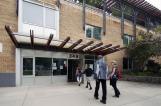 Credits:
Credits:Cabbagetown Regent Park Museum
Carol Moore-Ede
9
2011 Centennial YearJanuary 27th
Suhanna Meharchand of CBC News presides over the media launch of 100 years of Neighbours, marking the centenary of Central Neighbourhood House.
February 13th
Central Neighbourhood's first annual Winter Festival takes place in Riverdale Park West. With horse drawn sleigh rides, popcorn, hot chocolate, live music, tobogganing, hotdogs, hamburgers and other offerings - entirely free -this is the second in a series of at least twelve centenary celebrations of the House. Many participants, staff, and local neighbours join in and a good time is had by all, young and old.
March 27th
Central Neighbourhood House hosts a special afternoon of storytelling in the community. It is co-sponsored by Storytelling Toronto and features Clare Muireann Murphy, an international storyteller from Ireland; Carol Ashton and Sally Jaeger with stories for your children; Bilingual French stories told by Donna Dudinsky; and informal story sharing in a multicultural and multilingual community.
April 28th
The CNH Spring Concert is held at Lord Dufferin Public School in celebration of the creativity of its young community. Regent Park, Cabbagetown and St. James Town youth and children perform musical, dance, drama and spoken word pieces. In addition, 100 pieces of art prepared in celebration of CNH's centennial are unveiled.
May 5th
100 Years of Mothers: Motherhood from there to here; CNH hosts an afternoon tea and panel discussion with diverse perspectives on how mother hood has changed over the last 100 years. The panel is moderated by Pamela Couture of Emmanuel College, University of Toronto.
May 7th
CNH Jane's Walk: 100 Years of Social Inclusion led by CNH's Toby Mullally. This walk includes visiting CNH's first home, once a brothel; the Elizabeth Street Playground, focus of the famous CNH Children's Marches of the early years; and two other of our five locations over the last century, including its current home at 349 Ontario Street. The talk includes the history of the House and its neighbourhoods, its beginnings and early days, the battles in the neighbourhood, with City Hall and sometimes from within.
May 28th and 29th
CNH participates in Doors Open Toronto with droves of visitors admiring the building, facilities, and rooftop playground; as well as an archival photo exhibit prepared by the Cabbagetown Regent Park Museum, showcasing the first four decades of the 100 year old Central Neighbourhood House. Historians and local photographers are on hand to offer insight into the organization's rich history.
Later in the day on the 29th, a 100th Birthday Reunion is enjoyed by the CNH Alumni - staff, volunteers and participants - who know the value of CNH, and the unique approach it has always taken, working side by side with its neighbours to improve life in the community.
June 4th
100 Years of Social Change! is sponsored by CUPE 4308 and workers join with members of the CNH Youth Program to create a large and striking mural along the length of the building, representing 100 Years of Social Change.
July 16th
World of Neighbours - Celebrating 100 Years! multi-cultural fair is held in Allen Gardens with cultural entertainment, free food, and activities for the whole family. Some of the stage performers include: drumming sensation, Muhtadi; Nhapitapi, Afro-Zim Mbira and Dance; Bollywood sensation, Shweta Subram; and many others.
August 14th
Ontario Street Birthday Party is held by CNH and Cabbagetown South Residents' Association. Ontario Street is closed from Gerrard Street to Dundas Street so that people can safely stroll the area. Music is provided by Jazz Generation-5; and entertainment includes artists and artisans, children's activities, and historic walks.
September 24th
CNH presents The Jump Back Ball at the Thunderbird Café, Four Seasons Hotels and Resorts on Leslie Street. The event is hosted by media legend, Jojo Chinto, along with 100 Years of Neighbours Chair, Barbara Hall, for an evening of great entertainment and fine food in celebration of a century of service to Toronto's downtown east end.
November 3rd
An intimate evening with world renowned pianist, Anton Kuerti, is held at the St. Lawrence Hall, Toronto. The event is organized in support of the Central Neighbourhood House Innovations Fund, which creates programs and services that address issues of our aging population, food security, poverty, homelessness, and the needs of children.
Nov 17th
A Century of Photography from the archives of CNH, with photo restoration courtesy of Carol Moore-Ede and the Cabbagetown Regent Park Museum, opens at Mark Gleberzon's new gallery, MJG Gallery, at 555 Parliament Street. Many people drop in to this lovely new Gallery to enjoy a look back in history and enjoy a chat with owner. The speakers for the evening, are past Mayors David Crombie and Barbara Hall (Barbara was also Chair of the 100 Years of Neighbours Steering Committee). Barbara and David share their own memories of building community in downtown Toronto, and the role in history of Settlement Houses like Central Neighbourhood House.
December
A feast for the Holidays is held in December for the many program participants of CNH. In addition, Shamba Night is organized at Shamba Space for the volunteers who worked on the 100 Years of Neighbours project with great food, music and people celebrating the hard work that went into 15 fabulously successful events. It is a great end to a year of monthly celebrations.
10
Happy Centennial Central Neighbourhood House by Eric Morse1911
Downtown Toronto
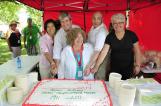 Credits:
Credits:Central Neighboourhood House
Eric Morse